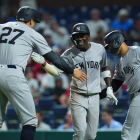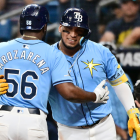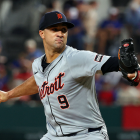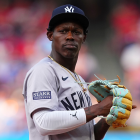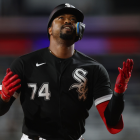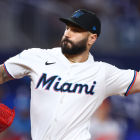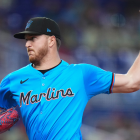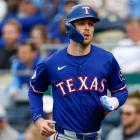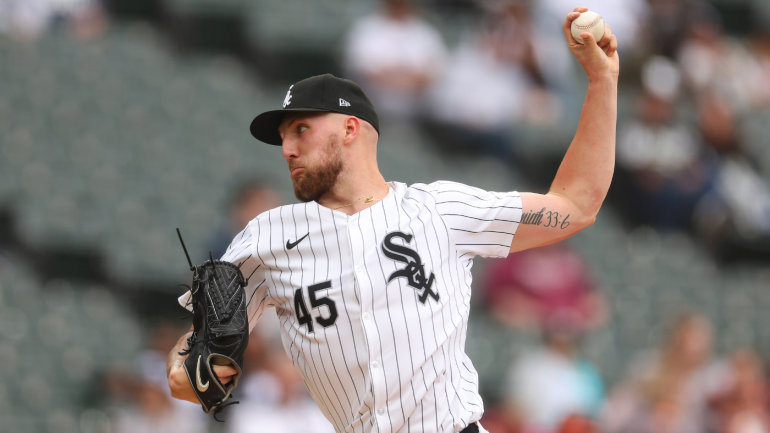
Major League Baseball's trade deadline is today, meaning that teams are at the finish fine to complete their midseason shopping. As is the tradition here at CBS Sports, we're kicking off the trade season by highlighting 30 players who could be on the move -- "could" being the operative word.
Trying to suss out which players are likely on the block and which aren't is always a difficult exercise. But the clustered National League wild-card race made this year's list even particularly tough to assemble. Surely a few teams will drop out over the coming weeks, but, for the most part, we avoided guessing which ones. Instead, we dedicated most of the list to teams we felt had clean decision trees ahead of them.
That means, in practice, that you won't find any New York Mets or Arizona Diamondbacks (among others) here despite there being a case for either team to sell. Inversely, you will find a few members of the Texas Rangers and Tampa Bay Rays, even though both clubs could defensibly buy over the coming weeks, depending on how things break.
All of this to say that our list might not have every name you expected. That's not because of an oversight; it's just because we made a different read on the team in question.
Additionally, we've included a few "potential suitors" for each player. It's mostly guesswork, though on some occasions we've baked in actual intel. It should go without stating that every player will have more than three teams interested in them, however, our lived experience suggests we should state it outright: there are more than three potential fits for every player; if your team isn't listed, feel free to mentally add them.
One final piece of housekeeping: the players are presented in order of a combination of two perceptions: their likelihood to move, and their probable impact.
With that out of the way, let's get to it.
1. Garrett Crochet, LHP, White Sox
It's easy to forget that Chicago's decision to put Crochet in their rotation this spring was met with skepticism; not because he lacked talent, but because he lacked precedent. He came into the year having thrown just 73 big-league innings since being drafted in 2020 because of various injuries. Though he's more than doubled that figure during the interim period, the question remains: how much can you rely on him the rest of the way -- this season, and from now until his winter 2026 date with free agency? No one can say for sure, leading to a wider than normal range of potential outcomes and returns. There's no reason to doubt a healthy Crochet's ability; he's introduced a cutter that works as a bridge pitch between his fastball and slider, giving him the kind of interplay that has transformed him into an above-average starter. All the stars in the sky will eventually burn out; Crochet will too. But first, if the heavens allow, the probable best starter moved this deadline could help determine who wins a pennant this October. Potential suitors: Orioles, Dodgers, Padres
2. Tarik Skubal, LHP, Tigers
Skubal has developed into one of the best pitchers in the majors, and he's going to receive American League Cy Young Award consideration barring two possible developments: 1) he hurts himself and misses significant time down the stretch; or 2) he gets traded to the National League at the deadline. Mind you, it's no sure thing that the Tigers seriously consider moving him. Some of the sources we spoke to for this piece believe the Tigers are likely to hold on to Skubal for at least the rest of this season, envisioning him still being part of their next playoff-caliber roster. Fair play, and that's why he's listed as No. 2 here instead of No. 1. Still, do be aware that he's closing in on free agency (winter 2026) a lot sooner than the Tigers might like given their uncompetitive state. Potential suitors: Dodgers, Orioles, Braves
3. Luis Robert Jr., CF, White Sox
You're not alone if you get some Eric Davis vibes from Robert. He's an incredible talent, a highly skilled center fielder with a track record of well-above-average offensive production. Yet his durability concerns are more significant than even Davis' were. Robert has played in more than 100 games just once in his first four seasons (he did play in 56 of 60 games in 2020). He needs 65 more appearances to get there this year, and we wish we could write that we were confident about it happening. Health is often described as the sixth tool; it's the one thing that's preventing Robert from being accepted as one of the best players in the league. As such, it'll be interesting to see how the market shakes out for Robert, and whether the final cost comes in lower than anticipated. Potential suitors: Dodgers, Orioles, Phillies
4. Bo Bichette, SS, Blue Jays
It's not so simple to describe this as pure cause and effect -- more goes into a team's fate than the contributions (or lack thereof) from one player -- but Bichette's disappointing season to date helps explain in part why the Blue Jays have underperformed. We still expect him to be a popular target over the ensuing weeks. Bichette isn't barreling the ball as frequently as he normally does, yet he's a 26-year-old with an established record of being a well-above-average hitter and another season of team control. We'll see if the Blue Jays want to tear down their core this summer; if so, Bichette should fetch the biggest return. Potential suitors: Braves, Giants, Guardians
5. Vladimir Guerrero Jr., 1B, Blue Jays
Time moves fast. It feels like just yesterday Guerrero was preparing to make his big-league debut; now, he's a season-plus away from free agency. A lot has changed during the interim period, including his position, but some things have remained the same. For instance, Guerrero remains a middle-of-the-order presence whose ability to impact the baseball is undeniable. There's no real need to address the rest of his game other than to note that teams tend to dock right-right first basemen. Should that prove to be the case here, the Blue Jays may end up holding him until at least the winter. Potential suitors: Mariners, Nationals, Astros
6. Zach Eflin, RHP, Rays (traded to Orioles)
The Rays have already traded one starter this month, sending Aaron Civale to the Brewers in exchange for a minor-league infielder. The return of several injured starting pitchers could allow them to deal another. Eflin is a logical candidate based on his contract: he's owed $18 million next season, a modest amount for his performance but a sizable one for the cost-conscious Rays. Besides, Tampa Bay's underlying measures are worse than its won-lost record indicates, suggesting that this Rays squad might lack The Juice for a serious run. Moving Eflin for some cost-controlled talent that can help now and later -- even if it causes some local annoyance -- seems like the kind of thing the Rays would do. Potential suitors: Braves, Dodgers, Astros
7. Mason Miller, RHP, Athletics
Every summer, we waste hundreds of words explaining why a non-contender should trade their hotshot reliever with years upon years of team control remaining. Relievers are fickle, we note, so get what value you can before their success proves fleeting. Teams never do it. Whether it be David Bednar, Justin Lawrence, or too many others to list, they hold onto their relievers -- and then, at some point in the near-future, they watch as their numbers fade and their value crashes. Will that happen with Miller? We sure hope not. The reality is, though, that MLB's hardest throwing pitcher (his fastball has clocked in at 100.8 mph on average) has been so hamstrung by injury that he's thrown just over 100 professional innings since being drafted in 2021. Does that sound like the kind of profile that's built to last? Again, hopefully Miller finds a way; his particular brand of pyrotechnics makes him one of the most exciting watches in the game. From a roster-management perspective, however, it feels wise for the A's to pursue a trade this summer. Potential suitors: Every contender
8. Nathan Eovaldi, RHP, Rangers
We'll see if the Rangers opt to sell instead of staying the course and hoping for a late surge. If they do, it would make sense for them to listen to offers on their veteran starter collection. While Max Scherzer's salary might overly complicate a deal, we felt it was worth including Eovaldi. He's having another strong season, after which he's likely heading to free agency as a 34-year-old with a lot of past injury concerns to his name. He's already helped two teams win World Series -- can he complete the hat trick? Potential suitors: Braves, Dodgers, Giants
9. Randy Arozarena, OF, Rays (traded to Mariners)
An ill-advised offseason swing change left Arozarena's seasonal numbers in a hole that he only started to dig out of in June. It's fair to think the Rays, as a result, may elect to hold onto him until at least the winter and give him a chance to repair whatever (if any) damage he did to his stock. We're including Arozarena anyway because let's face it: he's a proven middle-of-the-order bat who is getting expensive (at least by Tampa Bay standards) with two additional years of team control left after this one. That's a profile that plenty of clubs would be willing to overlook a couple of bad months to obtain. Potential suitors: Mariners, Royals, Phillies.
10. Cody Bellinger, CF/1B, Cubs
With the way the season has spiraled for the Cubs, we think they have to at least contemplate listening to offers for Bellinger. Remember, his three-year pact allows him to opt out after each season, meaning there's no actual assurance either way that he'll be on Chicago's roster come Opening Day 2025. We'll concede that Bellinger isn't having as good of a year as he did in 2023, and that teams may have additional concerns about his unusual profile as a result. That, in turn, could make it more likely that he stays in place -- either because teams are concerned he'll opt-in and decline, or because teams try to use that possibility to leverage the Cubs into a worse return. A well-timed heater between now and the deadline could change things, however, and even in this current reality, he's an above-average contributor capable of standing in center field. That's something. Potential suitors: Astros, Nationals, Mariners
11. Isaac Paredes, 3B, Rays (traded to Cubs)
Paredes is demonstrative evidence that a player can post meager exit velocities and still lead their team in home runs provided they're capable of pulling fly balls. While he doesn't fit the conventional analytical framework -- and it's possible that might cause some front offices pause -- it's tough to knock his production over the last two-plus seasons. He has a good feel for contact and he always walks his share; his glove is below average at third base, but some clubs will live with it to get this kind of bat in the lineup. Why would the Rays move Paredes when he's under team control through 2027? Two reasons: to take advantage of a dismal trade market for corner infielders, and to make space for top prospect Junior Caminero. Potential suitors: Dodgers, Mariners, Royals
12. Ryan McMahon, 3B, Rockies
The Rockies have indicated they won't move McMahon. There's no real impetus to do so: he's under contract through the 2027 season, and he's in the midst of a banner year. McMahon is hitting the ball much harder on average than normal (his exit velocity is up more than three ticks compared to last season), and he's on schedule to deliver his first above-average offensive effort as judged by park-adjusted OPS. That, plus the fact that he's a skilled defensive third baseman, means he's going to end up with a pretty WAR figure and possibly some down ballot MVP consideration. We think that teams will keep calling the Rockies on McMahon between now and July 30. Maybe someone convinces them to change their stance? Potential suitors: Dodgers, Yankees, Royals
13. Jazz Chisholm Jr., CF, Marlins (traded to Yankees)
The Marlins began their latest teardown earlier this summer, spinning Luis Arraez to the Padres for a four-player package. There's no reason for new top executive Peter Bendix to stop there, and Jesús Luzardo's injury leaves Chisholm as Miami's top trade chit. He should be in high demand based on a simple summation of his profile: he's a 26-year-old with center-field athleticism and an above-average career OPS+. Chisholm is under team control for an additional two seasons after this one to boot, making him more than a rental. As with Robert, the other top center fielder available, Chisholm has had his share of durability problems; we just don't think that's going to prevent a trade. Potential suitors: Cardinals, Guardians, Pirates
14. Jack Flaherty, RHP, Tigers
Give Flaherty credit: his stock is higher now than it was last deadline, when the Cardinals shipped him to the Orioles. He's throwing a little harder; he's generating more whiffs and more chases; and he has a dazzling statline despite not really altering his arsenal in a meaningful way. He's a free agent at year's end, and the Tigers have no reason to hold onto him past the deadline unless they want to use the exclusive negotiating window to work out a new deal. Shy of that, we'll note that Flaherty has been dealing with some back issues that haven't yet landed him on the IL; in turn, we have to assume they'll be a non-factor at the deadline. Potential suitors: Braves, Guardians, Astros
15. Erick Fedde, RHP, White Sox (traded to Cardinals)
Give Fedde credit for reinventing himself in South Korea after washing out with the Nationals, and give the White Sox credit for buying in over the offseason. He's since proven that his four-pitch attack -- sinker, cutter, sweeper, changeup -- can miss barrels against MLB competition, even if it seldom misses bats or causes hitters to expand their zones. Technically Fedde is under contract through next season, giving the White Sox another year to find a suitor. Why wait? Oftentimes, when it comes to 30-something mid-rotation starters, it's best to walk away when you're ahead. Potential suitors: Cardinals, Guardians, Braves
16. José Soriano, RHP, Angels
The Angels are under no obligation to move Soriano, who won't qualify for free agency until after the 2028 season. We know they'll get calls on him, however, and we suspect it may become apparent to them that trading him for a quality return would do more for their long-term prospects than keeping him around for another season or two. Soriano generates a lot of grounders with his upper-90s sinker, as well as a lot of whiffs with his spike curveball. His control has improved as the season has burned on, and a team convinced he's a starter for the long haul could pony up. Potential suitors: Guardians, Cardinals, Brewers
17. Carlos Estévez, RHP, Angels (traded to Phillies)
Estévez used a nearly perfect June to reset his season following a sluggish start to the year. (He appeared 10 times and surrendered two baserunners, both on singles.) Estévez, a fastball-slider righty, is now walking a career-low number of hitters while striking out close to a career-high. He has ample experience across the late innings, and he's also an impending free agent nearing his 32nd birthday. There's no reason for the Angels to hold on, and every reason for other teams to check in. Potential suitors: Every contender
18. Elias Díaz, C, Rockies
Díaz's All-Star Game appearance last summer became a joke of sorts as his park-adjusted numbers settled in close to his career norms. There's no laughing at his performance thus far this season. He's having a legitimately good year, albeit without the kind of accompanying underlying indicators that suggest he's made serious gains at or behind the plate. (His framing has graded significantly better in 2024 than in all but one of his previous seasons.) The sustainability of Díaz's apparent improvements may not matter because of the laws of supply and demand -- as in, there's a large demand for competent catchers and almost zero supply of them. Potential suitors: Nationals, Guardians, Pirates
19. Michael Kopech, RHP, White Sox (traded to Dodgers)
When it comes right down to it, player evaluation's main goal is figuring out what comes next. Oftentimes, what a player has done can provide hints; sometimes, not so much. There are cases, and clearly we mean like Kopech's, where teams will overlook meager or lacking topline performance in pursuit of glimmering innate traits. Kopech has struggled with walks and home runs dating back to last season, but we're confident some enterprising clubs will view him as a worthy buy-low candidate. Why? Because it seems to these eyes that he has a big-time arsenal that could lend itself to him serving as a late-inning stopper with the right supervision. Add in how he has an additional season of team control to get it right, and we expect his market to be more robust than you'd think. Potential suitors: Every contender
20. Taylor Ward, OF, Angels
There's a lot to like about Ward's game, even if he's probably best deployed in a timeshare or platoon role of sorts. He swings only at strikes; he has a knack for making hard, line-drive contact; and he has two additional seasons of team control remaining. (Trust us, we triple-checked after realizing that he debuted in 2018.) The main reason for the Angels to entertain moving Ward is straightforward: he's a solid, not star-caliber player over 30. This could be his value's apex. Potential suitors: Royals, Braves, Twins
21. Brent Rooker, OF, Athletics
Rooker was regarded as a Quad-A player entering last season. He had a good eye and immense strength from the right side, but he seemingly couldn't make enough contact for it to matter. He's since pieced together more than 800 plate appearances suggesting that he can walk and bop enough to obscure his extreme swing-and-miss tendencies. In theory, he's a middle-of-the-order bat with three more years of team control; in practice, other front offices might shy away from the potential downside that comes with this profile, especially as he nears his 30th birthday. Potential suitors: Mariners, Royals, Phillies.
22. Tommy Pham, OF, White Sox (traded to Cardinals)
When Pham signed with Chicago back in mid-April, everyone understood that his name would appear in these kinds of pieces provided that he held up his end of the bargain at the plate. We hereby decry that he did just that by hitting around a league-average clip despite being asked to play more center field than at any time since 2018. Pham's topline success shouldn't obscure that he's made less frequent hard contact than usual. Perhaps that's to be expected; he's nearing his 37th birthday, an age that has defeated plenty of perennial All-Stars. Pham never has made a Midsummer Classic and at this point it feels fair to write that he never will. He just might make another postseason appearance, however. Potential suitors: Braves, Mariners, Yankees
23. Cal Quantrill, RHP, Rockies
Prior to last season, Quantrill had established himself as a solid starting pitcher (albeit one incapable of missing bats). He had a miserable 2023, which ended with him being shipped to the Rockies to kick off the winter despite him having an additional year of team control after this one. While going to Coors Field is rarely a boon to a player's career, Quantrill has made the most of it by leaning into a splitter-heavy approach. He's still not a big-time bat-misser or anything, but this talking head could see a team with a wild imagination wanting to see what he can do in a more normal offensive environment -- e.g. one where he's not throwing moon rocks. Potential suitors: Astros, Brewers, Giants
24. Austin Gomber, LHP, Rockies
Fill a glass three-fourths of the way with water then top it off with Jordan Montgomery concentrate. You'll have Gomber. He's a no-frills lefty who doesn't do anything particularly well other than throw strikes. Hey, it's worked out OK for him, as he's pitched to a league-average park-adjusted ERA since the start of the 2023 season. Gomber has an additional year of team control remaining and ample experience in the bullpen, making him a potentially useful utility pitcher. If you squint, you can even see the potential for some pitch-usage alterations -- mostly in the form of further hiding his four-seam fastball -- that could boost his performance. Potential suitors: Guardians, Astros, Brewers
25. Tyler Anderson, LHP, Angels
Anderson has had a weird few years. He made the All-Star Game in 2022; flopped in 2023 after signing a three-year pact with the Angels; and now, if you just glanced at his ERA, you might think he's back to good. We're not so sure. Anderson's strikeout rate has cratered, to the extent that he's the qualified pitcher least likely to record a K. To his credit, he remains a skilled contact manager despite bleeding velocity; yet, to his debit, he's also handing out free passes at a career-worst rate. Overall, we think there's more bad than good going on here, and that teams might pause at taking him on for another season after this one. Still, it only takes one club to think that his shiny ERA will hold. Potential suitors: Giants, Astros, Padres
26. Lucas Erceg, RHP, Athletics (traded to Royals)
Erceg doesn't receive the kind of breathless coverage reserved for teammate Mason Miller, but he does have a fascinating backstory and an appealing game. He's a converted third baseman who didn't become a permanent pitcher until 2022. He's since established himself as a high-leverage arm thanks to a four-pitch mix that includes an upper-90s fastball and a slider that serves as his top bat-missing offering. Erceg, like Miller, has oodles of team control remaining. We see no reason for the Athletics to burn up more of it than they have to -- especially since he's closing on his 30th birthday. Potential suitors: Every contender
27. Tanner Scott, LHP, Marlins
Scott is like the Miami forecast: upper-90s giving way to some upper-80s. His fastball-slider pairing is capable of missing bats and barrels alike, resulting in one of the lowest average exit velocities against in the majors. His ability to manage contact is why he's been so effective this season despite a bloated walk rate (last season's measurable control gains were clearly an outlier) and a would-be career-low strikeout rate. Scott's a free agent at season's end, meaning that, just like the current Miami coastline, he'll be gone before you know it. Potential suitors: Every contender
28. Kirby Yates, RHP, Rangers
As noted above, it's to be seen if the defending champions commit to selling at the deadline. If they do, Yates is perhaps the most obvious candidate to go (or, at least, one of the most obvious, depending on how you clock fellow reliever David Robertson). He's a 37-year-old reliever having a phenomenal season thanks to his fastball-splitter combination. Yates' experience across the late innings can only be viewed as a bonus, too. Potential suitors: Every contender
29. Josh Bell, 1B, Marlins (traded to Diamondbacks)
On the one paw, Bell has been miserable this season. He's shown an offensive pulse only during the month of May, otherwise scuffling so badly as to fall well beneath the replacement-level threshold. On the other, Bell tends to get his numbers by the time the season ends, no matter how wandering the route he takes to get there. Add in how the Marlins have every incentive to facilitate a deal -- even if it means eating some of his remaining salary without demanding a grand return -- and you have to presume some club will sign up for whatever is coming over the season's final few months. Potential suitors: Mariners, Astros, Nationals
30. Paul DeJong, SS, White Sox (traded to Royals)
We don't know about you, but we're feeling déjà vu. DeJong was moved to Toronto last deadline after putting together a first half that doubled as his best extended offensive stretch in years. He cratered after changing addresses, causing the Blue Jays to cut him following just 13 games. Here we are, about 12 months later, and we feel obligated to proclaim caveat emptor. Someone's going to trade for DeJong because of his homer total and his ability to stand at the six; even so, there's a real chance he follows the same arc as last summer. His ball-tracking data isn't nearly as good as the aforementioned home runs would suggest, and he's sporting one of the ugliest strikeout-to-walk ratios in the majors. DeJong is no longer a plus defender, and he's never been a brilliant basestealer. He almost has to continue mashing beyond his means to maintain value, and while it's worked so far, we have a hunch that at some point between now and October his season is going to come undone. Potential suitors: Braves, Yankees, Mariners










